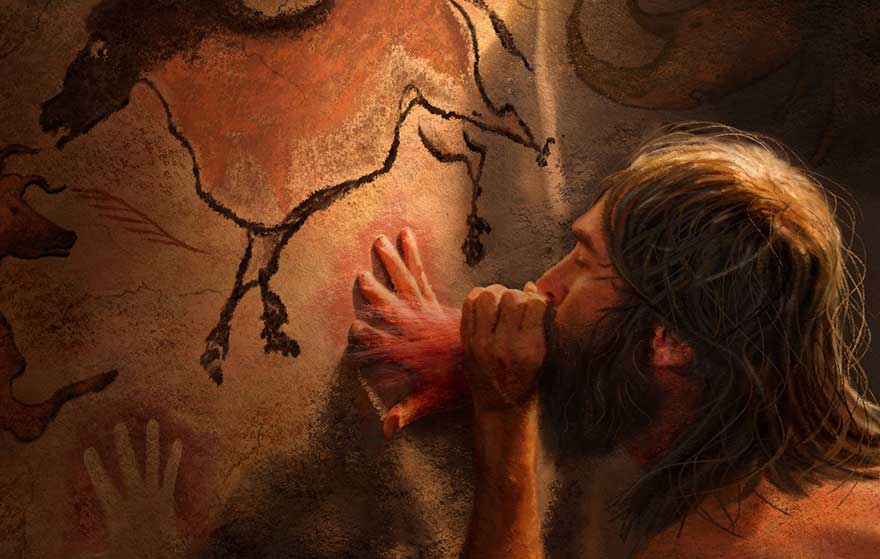According to textbooks, all modern humans come from a population that lived in East Africa about 200,000 years ago. This theory is based on some very serious evidence: genetic analysis of humans from all over the world and the discovery of human bones in Ethiopia between 195,000 and 165,000 years old.
But just recently, a large scientific team - of which I am a member - has discovered new fossil bones and stone tools that challenge this theory. The study that has just been published in the journal Nature in fact, pushes back the origins of our species by 100,000 years and suggests that the first humans had already invaded most of the African continent.

The Jebel Irhoud site in Morocco, where the fossils were discovered. Shannon McPherron, MPI EVA Leipzig
Men have always sought to understand their origins - whether biological or cultural. Archaeological excavations and the objects they uncover shed light on complex behaviours, such as tool-making, symbolic practices of burying the dead and artistic practices. As for understanding our biological origins, it is based on two main sources: fossil bones and teeth. More recently, the analysis of ancient genetic material - such as DNA - has also led to important advances.
This major discovery was made on the Moroccan site of Jebel IrhoudThis site has been known since the 1960s for its wealth of human fossils and particularly sophisticated stone tools. However, the interpretation of the Irhud fossils has long been clouded by uncertainties about their geological age. In 2004, evolutionary anthropologists Jean-Jacques Hublin and Abdelouahed Ben-Ncer have initiated a new excavation project there. They discovered stone tools and new fossils ofHomo sapiens from at least five individuals - mainly pieces of skull, jaws, teeth and bones.
Fossil dating
Some stone tools discovered on the site of Jebel Irhoud (Morocco). Mohammed Kamal, MPI EVA Leipzig
In order to date these discoveries, the team's geochronologists used an thermoluminescence dating method on the stone tools found on the site.
By taking into account the level of natural irradiation of the environment where the tool has stayed and the nature of the crystals involved, the precise date of the last heating of the sample can be calculated.
So we can measure the accumulated radiation to determine how long the tools were buried. This analysis indicated that the tools were approximately 315,000 years old, to the nearest 34,000 years.
The researchers also applied the electron spin resonancewhich is a similar technique, but for analyzing teeth. One of the teeth found at the site was thus dated to 286,000 years ago, with a margin of error of 32,000 years. All these analyses indicate thatHomo sapiens - in other words, modern humans - lived in the northwestern quarter of the African continent much earlier than previously thought.
But how can we be sure that these fossils belonged to a member of our species and not to an older ancestor? To answer this question, the team's anatomists used the high-resolution computed tomography (CT scan) to produce detailed digital copies of these precious and fragile fossils.
They then virtually reconstructed the face, skull cap and lower jaw of all the specimens discovered, and using sophisticated measurement techniques, they were able to determine that these fossils had a modern morphology. They can therefore be distinguished from all other human species known - thanks to their fossils - to have lived in Africa during the same period.
High-resolution scans have also been used to analyze the structures hidden in dental crowns, as well as the size and shape of dental roots hidden in the jaws. These analyses, which were the focus of my contribution, revealed a number of dental characteristics similar to those of other modern human fossils.
Although their characteristics are more primitive than the teeth of today's humans, they are markedly different from, for example, those ofHomo heidelbergensis andHomo neanderthalensis. This discovery and scientific analyses confirm the importance of Jebel Irhoud as the oldest site documenting an early stage of the origin of our species.
Archaeology versus genetics
As a paleoanthropologist who focuses on the study of fossil bones and teeth, I'm often asked why we don't just treat these questions using genetic analysis. There are two main reasons for this. Although incredible progress has been made in the recovery and analysis of genetic material from fossils hundreds of thousands of years old, it seems that this type of analysis is only possible under particular (and unfortunately rare) conditions of burial and fossilization, namely low and stable temperature.
This means that there are fossils for which we will never be able to obtain genetic data and we must therefore rely on the analysis of their morphology, as we already do for other very interesting questions relating to the early periods of human evolution.

Fossils as discovered. Steffen Schatz, MPI EVA Leipzig
Furthermore, understanding the genetic basis of our anatomy only teaches us part of what it means to be human. Understanding, for example, how behaviour over the course of our lives can alter the external and internal structure of the bones of the hand can help reveal how we used our hands to make tools. Similarly, measuring the chemical composition and cellular structure of our teeth can reveal what we eat and help us understand our development during childhood. It is these factors that help us truly understand how you and I are both similar and different from the early members of our species.
The pan-African origin ofHomo sapiens (Paris press conference on the discovery of Jebel Irhoud, 7 June 2017) photo Aline Richard
And, of course, we should not forget that it is thanks to archaeology that we know when we began to adopt artistic practices, to adorn our bodies with jewellery, to make sophisticated tools and to access a diverse range of plant and animal resources. In fact, some scientists argue that human species prior to Homo sapiens had already adopted some of these incredible behaviors.
Future advances in research will reveal the uniqueness of our history and the evolution of our lineage. So let's encourage a new generation of young scientists to search for new fossils and make archaeological discoveries that will help us put together the complete puzzle of human evolution!
Matthew SkinnerSenior Lecturer in Evolutionary Anthropology, University of Kent
The original text of this article was published on The Conversation.














